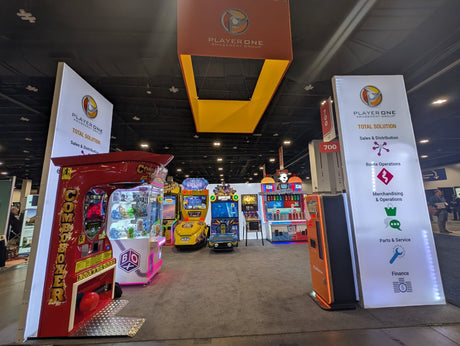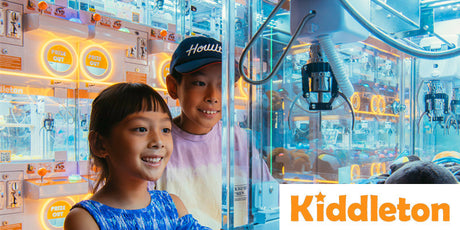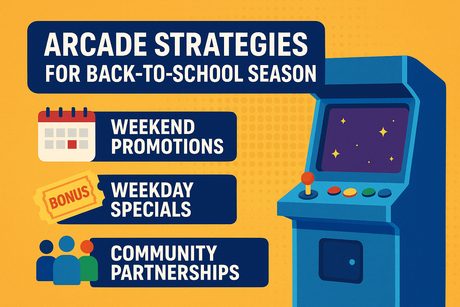Keeping your arcade fresh is a never-ending quest—like trying to nab the elusive stuffed animal in a claw machine. If you’re an FEC (Family Entertainment Center) owner or operator, you already know how crucial it is to keep things interesting. But “rotation” doesn’t always mean hauling in new machines; sometimes it’s as simple as rearranging your current lineup.
In this blog, we explore why game rotation (and relocation) matters, how to identify underperforming games, and tips for supercharging your revenue with new—or newly placed—attractions.
We also seek advice from our resident FEC expert, Alyssa D’Souza, Director of FEC Operations here at Player One Amusement Group.
Why Arcade Game Rotation Matters
Game rotation might sound like a fancy term for “swapping out old machines,” but it’s a core strategy for keeping players engaged and hungry for more.
“Game rotation isn’t just about swapping in something new—it’s about keeping your guests excited, engaged, and eager to return. By analyzing revenue data and listening to customer feedback, you can continually refresh your arcade without losing the timeless classics people love.”
— Alyssa D’Souza, Director of FEC Operations
Prevent Player Fatigue: Even the hottest game can lose its shine after sitting in the same corner for months. Rotating titles, or simply moving them to new spots, sparks curiosity and boosts repeat visits.
Adapt to the Arcade Industry Trends: Gaming is fast-paced. By regularly refreshing your lineup, you can jump on new trends and keep your arcade relevant—whether that’s the latest VR shooter or a retro favorite making a comeback.
Maximize Revenue per Square Foot: Every inch of your arcade is prime real estate. Swapping low earners—or placing them in a more favorable spot—can transform underperforming games into solid revenue contributors.
Identifying Underperforming or Under-Positioned Games
Knowing which games to rotate starts with spotting those that aren’t pulling their weight.
Check the Numbers: Modern POS and card-swipe systems reveal plays per day, average spend, and total weekly or monthly earnings. If a machine’s stats are significantly below the arcade average, it’s time for a closer look.
Solicit Guest Opinions: You can learn a lot by simply asking your players. Quick surveys, social media polls, or casual in-person chats will highlight which games they’re skipping and why.
Observe Foot Traffic: If a game consistently sits idle during peak hours, there’s likely a layout or interest issue. Sometimes, a better location—or a different game altogether—can remedy the situation.
Don’t Forget the Layout: Moving vs. Swapping
A slow earner isn’t necessarily a bad game—it might just be in the wrong spot.
- Highlight Crowd-Pleasers: Place your flashiest, best-performing titles in high-traffic zones (near entrances or walkways).
- Create Themed Zones: Consider grouping your shooters, racers, and retro classics into dedicated areas to boost discovery and flow.
- Mind Sightlines: A popular but physically smaller game might be overshadowed by larger games. Simply shifting it to a more open area can make all the difference.
“Sometimes, simply relocating a game to a more visible or high-traffic spot can transform a slow earner into a star performer. We’ve seen arcades gain a revenue boost just by smartly repositioning their games.”
Planning Your Rotation Schedule
Rotation doesn’t have to be chaotic. A well-thought-out schedule keeps your arcade fresh without confusing loyal regulars.
Seasonal Shake-Ups: Tie major changes to seasons or holidays—spring break, summer vacation, Halloween—for maximum hype. Align new or relocated games with the season’s biggest themes.
Incremental Updates: Aim to change or relocate 20–30% of your games yearly. You’ll maintain variety without losing customer favorites in one fell swoop.
Consider Revenue-Sharing Models: Buying new machines is an investment. Revenue-sharing or leasing models (like those offered by P1AG) let you test new titles without excessive upfront costs. When trends shift, you have the flexibility to swap them out quickly.
Maximizing Returns on Rotated or Repositioned Games
Once you’ve decided which games to move or introduce, let everyone know.
Promote Your Updates: Use social media, email newsletters, and in-store signage to spotlight your new or newly relocated games. Even a subtle change can spark fresh interest among regulars.
Host Mini-Tournaments: Friendly competitions around a relocated title (like a racing or shooting game) draw crowds—and create buzz about your arcade’s new layout.
Leverage Loyalty Programs & Play Cards
Reloadable play cards can work hand-in-hand with rotation strategies. Offering discounted credits nudges guests to try something different—and encourages them to come back again.
“Reloadable play cards are a powerful way to build customer loyalty. They streamline the experience for guests, help parents budget more effectively, and give operators valuable insights into player behavior—all of which drive repeat visits.”
Measuring Success After Changes
Regularly review the data to see if your adjustments are paying off.
- Boost in Revenue: Did your repositioned game see an increase in daily or weekly earnings?
- Higher Foot Traffic: Are more guests checking out the newly arranged areas?
- Guest Feedback: Positive comments, social media chatter, and increased word-of-mouth are all signs you’re on the right path.
Embrace Change for a Thriving Arcade
Arcade success hinges on your willingness to adapt. Rotating games keeps your venue feeling new, aligns your offerings with evolving trends, and maximizes every square foot of your space. And when you need a helping hand or the hottest new titles, Player One Amusement Group is here to help,
“At P1AG, we don’t just deliver the hottest new titles. We work side by side with operators to design the best floor layout, implement data-driven strategies, and ensure their arcades remain competitive in a rapidly evolving market.”
Ready to Level Up Your Arcade?
Reach out to Player One Amusement Group (P1AG) for expert guidance on game rotation, revenue-sharing options, and the industry’s hottest titles. With the right strategy, you’ll keep guests excited, engaged, and eager to come back for more—one well-placed game at a time!








